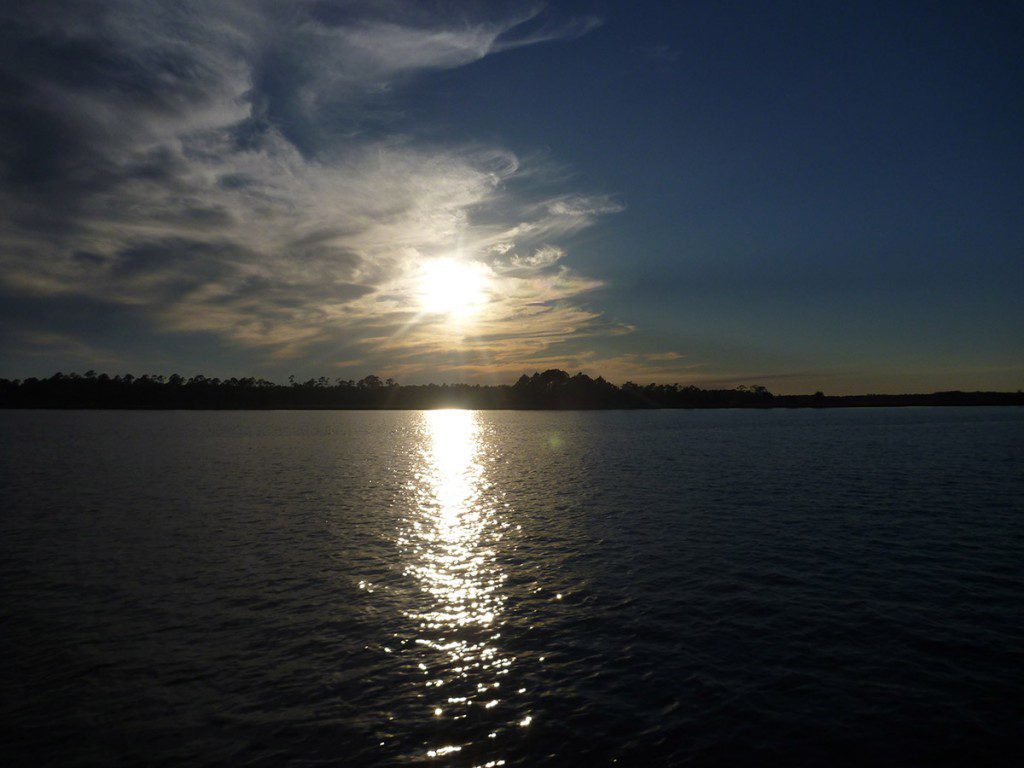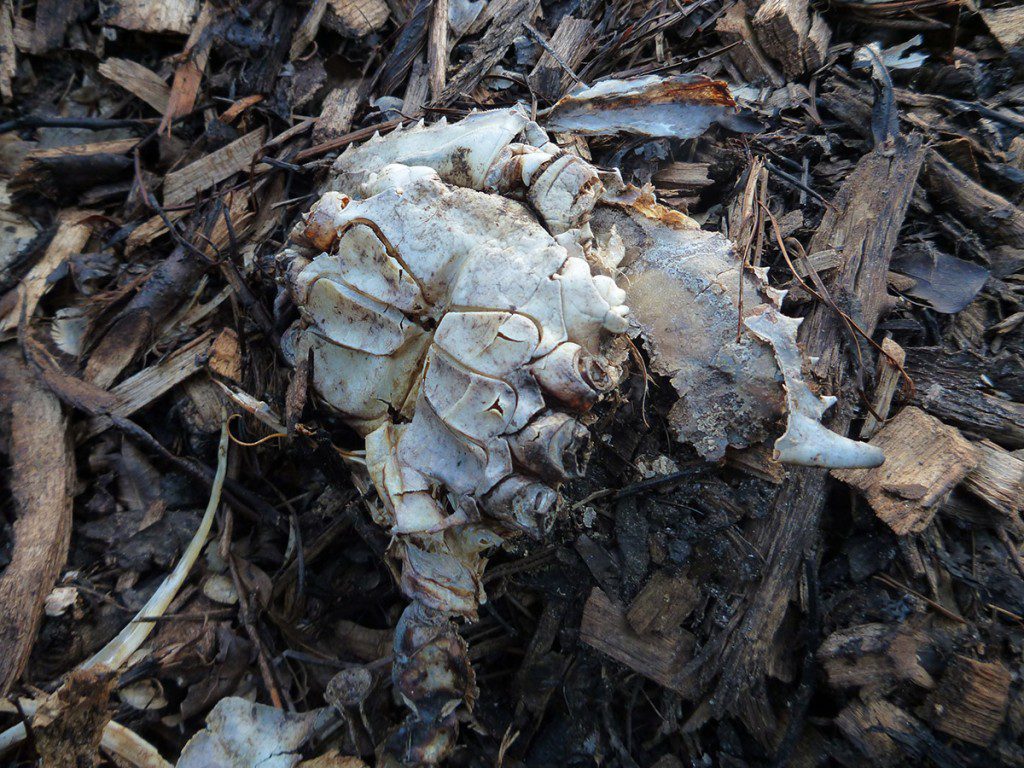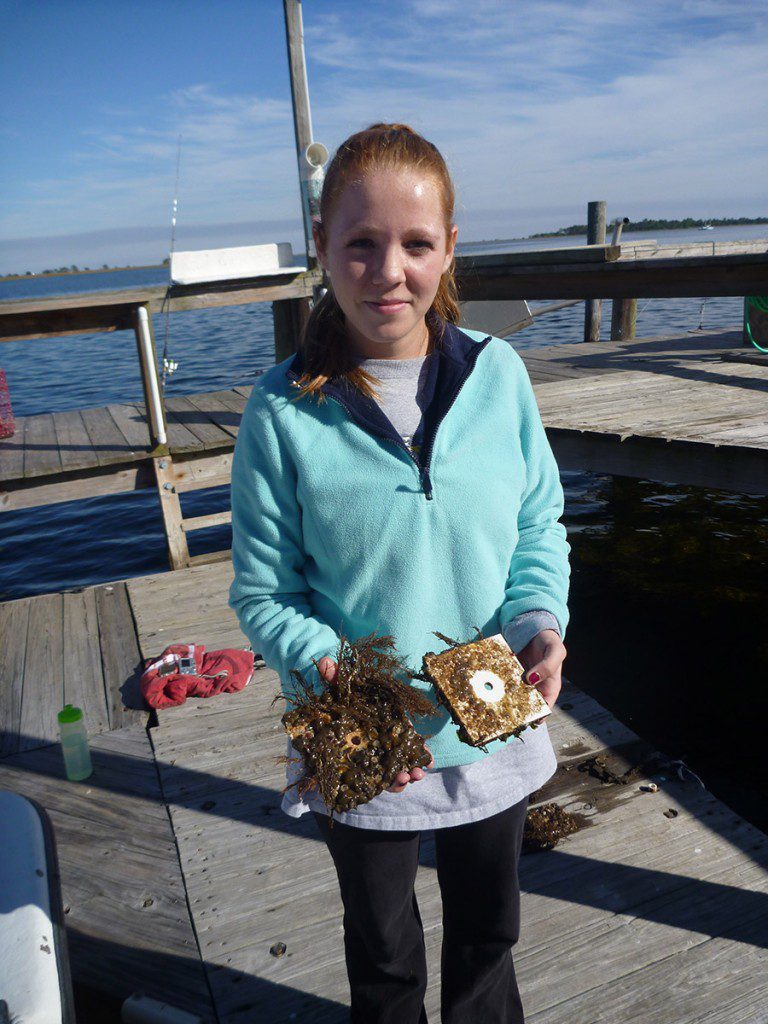Video: Interns at the Gulf Specimen Marine Lab in Panacea, FL, get hands on experience working with marine life and equipment.
Rob Diaz de Villegas WFSU-TV
We’re on a boat, speeding through Apalachee Bay on our way back to land. We’ve accompanied Cypress Rudloe and two Gulf Specimen Marine Lab interns on a trip to collect samples. Buckets full of octopus and sea urchins slosh as I take a good look to my left and right and get a firm perspective of where I am. We’re several miles from the St. Marks Lighthouse; it stands out unmistakably as it was designed to do. Smoke unfurls over it and into the Gulf, from a controlled burn on the St. Marks National Wildlife Refuge. I look left and see the mouth of the Ochlockonee River, and follow the contour of the land as it curls out of sight to Alligator Point. These interns are preparing for a life that keeps them in places like this. Bravo.
 Of course, it’s more than merely being outdoors that they’re getting out of the deal. They’re learning about sea turtle rescue, collecting specimens in the wild, and outreach activities. This includes leading tours and taking the Seamobile out to where kids who don’t always make it to the coast can touch a horseshoe crab. The day after our trip, the Seamobile is going to Thomasville, GA for a festival. The stingray and horse conch that inhabit the tank at the rear of the mobile aquarium will be traveling dozens of miles from their home, but to a place bound to their home nonetheless. Making that connection is part of the educational outreach that interns perform.
Of course, it’s more than merely being outdoors that they’re getting out of the deal. They’re learning about sea turtle rescue, collecting specimens in the wild, and outreach activities. This includes leading tours and taking the Seamobile out to where kids who don’t always make it to the coast can touch a horseshoe crab. The day after our trip, the Seamobile is going to Thomasville, GA for a festival. The stingray and horse conch that inhabit the tank at the rear of the mobile aquarium will be traveling dozens of miles from their home, but to a place bound to their home nonetheless. Making that connection is part of the educational outreach that interns perform.
“We take the Seamobile around and do programs on sea turtles, coastal watersheds, marine invertebrates,” Tom Harrah told me as he loaded some critters into one of its tanks. Tom manages the Seamobile and the intern program at Gulf Specimen.
Just a few miles west of Thomasville is the upper Ochlockonee River. This makes it a part of Apalachee Bay’s coastal watershed. If rivers are the strings that connect places like Thomasville to the bay, then standing on this boat I am over a knot. Two watersheds meet here, the Ochlockonee and St. Marks, rivers whose mouths I can alternately see by turning my head one way or the other. Somewhat by design, every video I’ve produced over the last few months tugs at this knot, and standing here I trace my way backwards to farms and through underwater caves.

Both Full Earth and Turkey Hill Farms compost using fish waste. The compost should release less nitrogen into waterways than synthetic fertilizers. Both farms are near rivers that drain into Apalachee Bay, so a more efficient means of fertilizing their crops helps keep the watershed cleaner, ultimately benefiting the species that provide fuel to their plants.
In our last segment we covered two farms in the Ochlockonee watershed. Full Earth Farm co-managers Katie Harris and Aaron Suko are cognizant of where their farm is in relation to the river, and it influences the way they work their land. “We don’t want to negatively impact the local waterways and the groundwater.” Aaron told me. “That’s, I’d say, one of the primary reasons we don’t use synthetic fertilizers.” In our first segment on the Red Hills Small Farm Alliance, I talked to Louise Divine. She and her husband, Herman Holley, run Turkey Hill Farm just east of Tallahassee, and near to a small waterway named Black Creek. Like Full Earth, Turkey Hill is an organic food grower. And like Aaron and Katie, Louise and Herman are well aware of their place in the watershed. “I think about it every day.” Louise said. “I think about it when I drive down the highway and I see Roundup sprayed everywhere. And I know that that Roundup ends up in Black Creek and I know that Black Creek goes into the St. Marks and I- it makes me insane.”
Excess nitrates from fertilizers figure prominently in stories we’ve done on Wakulla Springs. It runs off of lawns in Tallahassee and down streets, into sinkhole lakes like Upper Lake Lafayette or into Lake Munson, a heavily polluted waterway that drains into Ames Sink. Dye trace tests have linked Ames Sink to the springs, its water running through one of the largest underground cave systems in the country. Nine miles or so after its water emerges from Wakulla Spring, the Wakulla River meets up with the St. Marks. Wakulla Spring has suffered from an increase an algae due to excess nitrates. Perhaps due to tidal influence, the lower river’s water appears to be cleaner.

Chloe Jackson is an honors biology student at Florida State University. She interned at the Gulf Specimen Lab over the summer, and is currently using their dock for an experiment using recruitment tiles (which should look somewhat familiar for those of you who followed In the Grass, On the Reef over the last few years).
Both the St. Marks and the Ochlockonee provide an important influx of freshwater to coastal ecosystems. “There’s a high level of biodiversity in this area” Tom Harrah said. “There are a lot of rivers coming into the ocean, dumping nutrients. And there’s just animals everywhere.”*
Tom was new to the area when he volunteered at Gulf Specimen as an FSU biology major. Eight years later, he’s still here working and enjoying these natural resources. Intern Cara Borowski’s love of these natural resources manifested itself in a different way, as we cover in the video above. For her, the thrill is getting kids interested in ecology and fostering a spirit of stewardship. When she entered the program, she was aiming to be a research biologist. Now, she’s thinking more about education. Without an opportunity to host field trips and take the Seamobile to schools, she might never have considered this career path.
*If you’re confused about the roles of nutrients, which can cause lethal algal blooms but also provide a foundation for all life on earth, I’ll direct you to this blog post written by Dr. David Kimbro about the nitrogen cycle.
